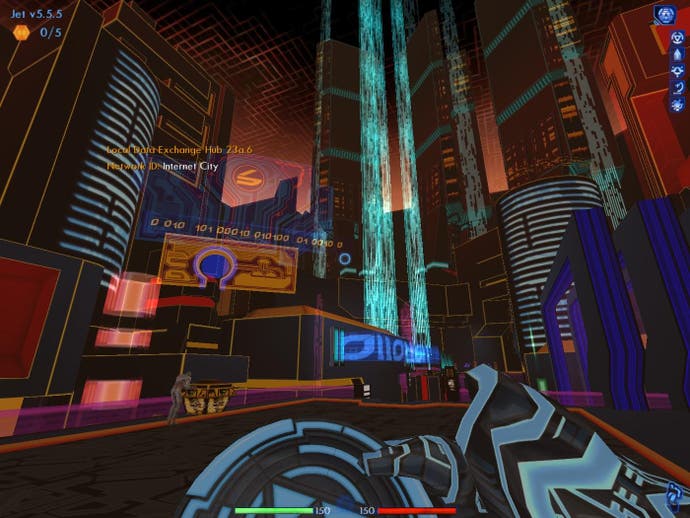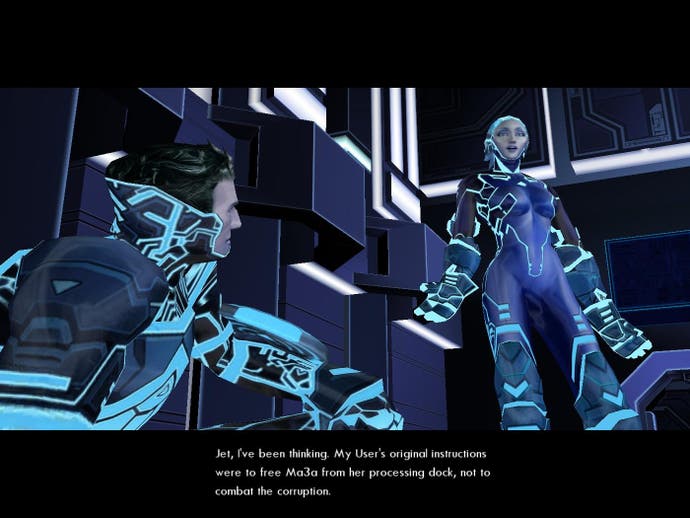Retrospective: Tron 2.0
Please remain assembled during authorisation.
There's a sequel to Tron coming out soon. The film. The 1982 Disney classic, which on viewing today is in equal parts brilliant and bemusing.
It's a very family-friendly film, and yet makes absolutely no effort to be understandable by kids. Its esoteric ideas of the programs inside our computers being sentient AIs - who not only complete the tasks they're given, but have personalities, desires, a will to live - aren't introduced. It's just that way. A corporation able to grow evil enough to take over the world through the success of videogames? Oh, well, maybe that was more realistic. But not in '82.
Monolith's Tron 2.0, made following its absolutely superb No One Lives Forever spy comedies, was the company riding a high. It was two years before F.E.A.R. transmuted it into a bunch of miseryguts with its dreary, solemn Condemned games. It still had spirit, and Tron 2.0 is bursting with the stuff.
Looking at trailers for next month's cinematic sequel, Tron: Legacy, it's odd quite how similar their core plot is to Monolith's own. While the film has Kevin Flynn's adult son attempting to rescue his father from within the machine, Tron 2.0 has Alan Bradley's son, Jet, rescuing his father in the digital world.

And like the film, along the way Jet is helped by a pretty female program, Mercury. (In the film it's Olivia Wilde playing Quorra.) Oh, and if we're listing similarities, in Tron 2.0 you spend a good portion of the game looking for a new version of Tron's code, called Tron: Legacy. So go figure.
As Jet, you charge about in a first-person shooter, attempting to take out malevolent or corrupted code, while chatting with the friendly denizens of the data. What's odd to realise going back to it is quite how much there is of the latter.
My lasting memories were of three things: 1) The pink worm monster thing I could never beat. 2) The light cycle races I could never win. 3) The Disc weapon. What I'd forgotten was that it was in many ways as much of an RPG as Deus Ex.
Not only is there a good deal of walking through friendly areas, or areas populated with friendly NPCs at least, but there's a lot of chitchat with them and your companions. Combined with this is the levelling up - something that's so incredibly rarely featured in an FPS. And then on top of that is the absolutely superb way it lets you add in various abilities, augmentations and weapons.

You're given a disc with a limited number of memory spaces (the number and the spacing changing with each chapter of the game), and a collection of subroutines that go into the spaces. These are everything from armour and weapons to sneaking, jumping and scanning abilities. Subroutines come in three versions: alpha, beta and gold.
Better versions take up fewer memory spaces. So every area is about balancing from your pool of tools, selecting what you think will be most helpful for the level, and then trying to arrange them as efficiently as possible. It means you can't just have sixty-seven weapons available at any time. Carrying a weapon means sacrificing something else. It's an excellent exchange.
But what I love most is that you can get most the way through the game using the starting disc weapon, or perhaps with its first upgrade, the Disc Sequencer (which fires multiple discs at once, rather than waiting for the one to arrive back).

